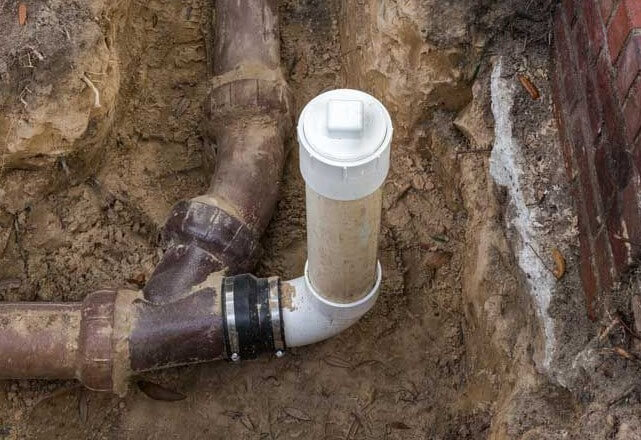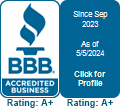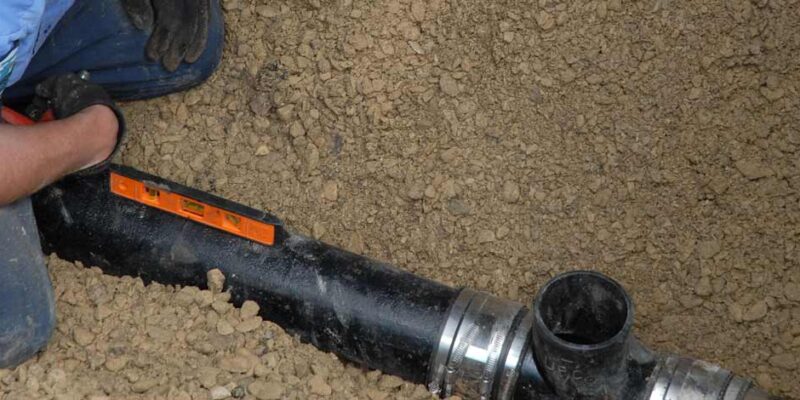

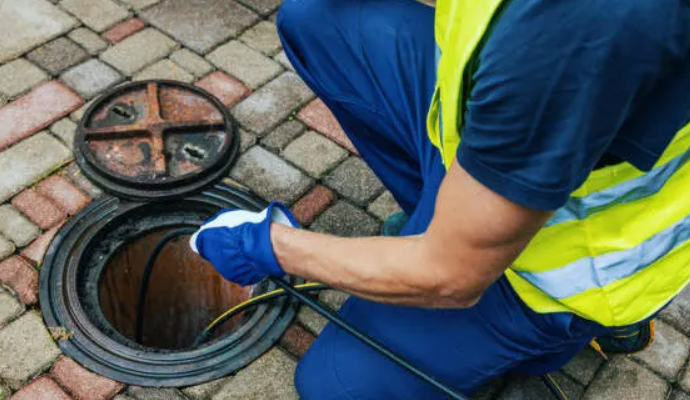
How Much Does It Cost to Repair a Sewer Line?
How Much Does It Cost to Repair a Sewer Line? Understanding the Factors and Budgeting for Repairs
Dealing with a sewer line issue is not only inconvenient but can also be a concern for homeowners wondering about the associated costs. The price of repairing a sewer line can vary widely, influenced by several factors. In this article, we’ll explore the key considerations that impact the cost of sewer line repair, helping homeowners understand the potential expenses and plan accordingly.
In a hurry? Contact us at (727) 350-6465
Factors Influencing Sewer Line Repair Costs:
Type of Repair Needed:
The specific issue with your sewer line plays a significant role in determining the cost of repairs. Simple fixes such as clearing a clog or repairing a small crack may be more budget-friendly compared to extensive repairs or a full sewer line replacement.
Location of the Problem:
The location of the sewer line problem can impact the cost. Issues closer to your home, such as those in your yard, may be less expensive to repair than problems farther down the line, closer to the main sewer connection. Accessibility and ease of reaching the affected area can influence the overall cost.
Severity of the Damage:
The extent of the damage to your sewer line is a crucial factor. Minor issues like small cracks or leaks may require less extensive repairs, while major problems such as a collapsed or severely damaged line may necessitate more significant and costly solutions.
Type of Material Used:
The materials used for repairs also contribute to the overall cost. Traditional materials like PVC or cast iron are common choices, but some homeowners opt for trenchless technologies, which can be more expensive initially but offer advantages such as reduced disruption and faster completion.
Local Labor Rates:
Labor costs vary based on location and local market rates. Areas with a higher cost of living or a greater demand for plumbing services may have higher labor rates, impacting the overall cost of sewer line repairs.
Permitting and Inspection Fees:
Obtaining permits for sewer line repairs and undergoing required inspections may incur additional fees. Municipalities often charge for permits and inspections to ensure that the repairs meet safety and building code standards.
Emergency Repairs:
If your sewer line issue requires immediate attention due to an emergency, the urgency may lead to higher costs. Emergency repairs often involve expedited services and additional resources, contributing to an increased overall expense.
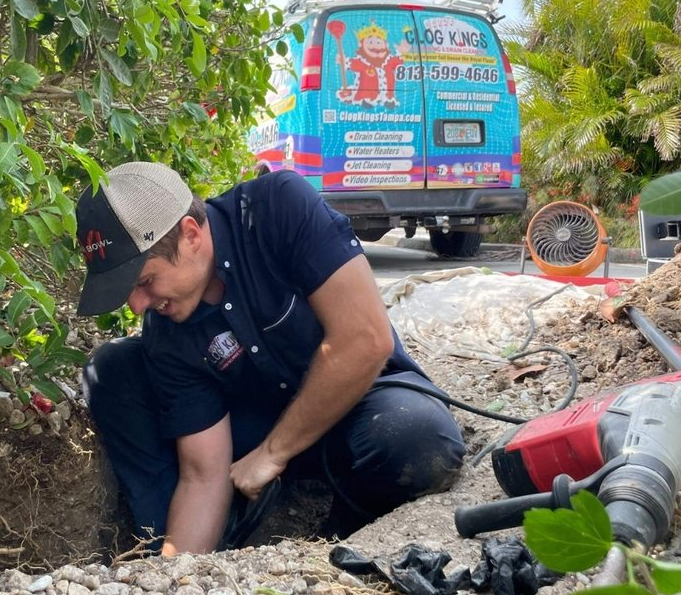
REQUEST A FREE ESTIMATE
In a hurry? Contact us at (727) 350-6465
Common Sewer Line Repair Scenarios and Costs:
Clearing a Clog:
Clearing a simple clog using methods like snaking or hydro jetting is a more affordable repair, typically ranging from $100 to $400. This cost can increase if the blockage is deep within the sewer line.
Patch or Seal Repairs:
Repairing small cracks, leaks, or joints in the sewer line with patching or sealing materials can cost between $100 and $400 per linear foot. This approach is effective for minor damage but may not be suitable for more extensive issues.
Trenchless Pipe Lining:
Trenchless pipe lining is a modern method that involves inserting a liner into the existing sewer line, creating a new, durable pipe within the old one. This method can cost between $80 and $250 per linear foot but offers advantages like minimal disruption and a longer lifespan.
Traditional Pipe Replacement:
Completely replacing a sewer line with traditional methods can range from $50 to $250 per linear foot. This approach involves excavating the old pipe and installing a new one. Costs can vary based on the depth and accessibility of the sewer line.
Excavation and Replacement:
In cases where the sewer line is severely damaged or collapsed, excavation and replacement may be necessary. This method can cost between $50 and $250 per linear foot, depending on factors like the depth of the line and the type of material used.
Budgeting for Sewer Line Repair:
Obtain Multiple Quotes:
Before committing to any repair, obtain quotes from multiple plumbing professionals. This allows you to compare costs, services, and proposed solutions, ensuring you make an informed decision.
Understand Your Insurance Coverage:
Check your homeowners insurance policy to understand what, if any, coverage is provided for sewer line repairs. While insurance typically doesn’t cover wear and tear, sudden and accidental damage may be eligible for coverage.
Consider Financing Options:
If the cost of sewer line repair exceeds your immediate budget, explore financing options. Some plumbing professionals offer financing plans or work with third-party financing companies to help homeowners manage the expenses over time.
Preventive Maintenance:
Regularly maintain your plumbing system to identify and address issues before they escalate. Performing preventive maintenance can help minimize the risk of significant sewer line problems, reducing the likelihood of extensive and costly repairs.
Emergency Fund:
Build an emergency fund for unexpected home repairs, including sewer

Call Clog King Now!
Clog Kings is committed to providing you with all the information you need and answering your questions, enabling you to make an informed decision for yourself and your home. If you have questions about sewer lines, or are having problems with your plumbing, You can also contact a member of our team at (727) 350-6465 for further discussion.
Our Other Services
Clog King’s plumbers strive to provide great customer service from start to finish. Our services include:
- Drain Cleaning
- General Plumbing Repair
- Sewer Repair
- Sewer Replacement
- Tankless Water Heater Installation
- Toilet Repair
- Video Plumbing Inspection
- Water Heater Replacement
- Expert Water Softener Installation Services
- Water Filtration
Don’t let these problems disrupt your daily routine or cause further damage to your property! Take charge and call the royal experts at Clog Kings for top-notch plumbing solutions. Contact us today!
REQUEST A FREE ESTIMATE
In a hurry? Contact us at (727) 350-6465

Who Is Responsible for Sewer Line Repair
Who Is Responsible for Sewer Line Repair? Unraveling the Responsibilities and Solutions
Sewer line issues are a common concern for homeowners, and when problems arise, it’s crucial to understand who is responsible for sewer line repair. In this article, we will delve into the intricacies of sewer line ownership, maintenance, and repair, aiming to shed light on the often perplexing question of responsibility.
In a hurry? Contact us at (727) 350-6465
Understanding Sewer Line Ownership
Sewer lines are an integral part of a property’s plumbing system, responsible for carrying wastewater away from our homes to the municipal sewer system. However, determining ownership of these lines can be confusing. In most cases, homeowners are responsible for the maintenance and repair of the sewer lines on their property, extending from the house to the point where it connects with the municipal sewer system.
Municipal Responsibility
While homeowners typically bear the responsibility for their sewer lines, municipalities often take charge of the main sewer lines that run beneath public streets. These main lines connect individual properties to wastewater treatment plants. Problems that occur within these main lines are generally the responsibility of the local government or sewage district.
Common Causes of Sewer Line Issues
Understanding the common causes of sewer line problems is essential in identifying responsibility. Tree roots, aging pipes, improper disposal of non-biodegradable items, and soil movement are among the leading causes of sewer line issues. Recognizing these factors can help homeowners take preventive measures and municipalities plan for necessary maintenance.
Homeowner Responsibilities
As a homeowner, it is crucial to be proactive in maintaining your sewer lines. Regular inspections and proper waste disposal habits can go a long way in preventing major issues. Homeowners are responsible for addressing problems within their property boundaries, including the lateral sewer line that connects their home to the main sewer line.
Signs of Sewer Line Issues
Recognizing the signs of sewer line problems early on can save homeowners from extensive damage and costly repairs. Common indicators include slow drains, gurgling noises, foul odors, and sewage backups. If any of these signs are present, it is essential to act promptly to prevent further damage and potential health hazards.

REQUEST A FREE ESTIMATE
In a hurry? Contact us at (727) 350-6465
Professional Inspection and Maintenance
Professional sewer line inspections are a wise investment for homeowners. Trained technicians can use advanced technology, such as cameras, to inspect the condition of sewer lines without invasive digging. Regular maintenance, including cleaning and clearing debris, can also help extend the lifespan of sewer lines.
Insurance Coverage
Homeowners should review their insurance policies to understand coverage related to sewer line repairs. While many standard policies may not cover sewer line issues, additional endorsements or a separate sewer line insurance policy can be obtained. Knowing the extent of insurance coverage can help homeowners plan for potential expenses.
Legal Considerations
In some cases, the responsibility for sewer line repair may involve legal considerations. Homeowners should familiarize themselves with local laws and regulations governing sewer systems. Consulting with legal professionals can provide clarity on liability in case of disputes or unclear responsibility.
Community Collaboration
In some communities, there are programs or initiatives that promote collaboration between homeowners and local authorities for sewer line maintenance. These efforts can include subsidies, educational campaigns, or joint projects to address common sewer line issues. Homeowners should inquire about such initiatives in their local area.
Conclusion
Understanding responsibility is key to proactive maintenance and cost-effective solutions. Homeowners play a crucial role in maintaining their individual sewer lines, while municipalities oversee the main lines beneath public streets. Recognizing the signs of sewer line issues, investing in professional inspections, and staying informed about insurance coverage are vital steps for homeowners. By fostering a sense of community collaboration and adhering to legal considerations, we can collectively address sewer line challenges and ensure the longevity of our plumbing systems.

Now you know who is responsible for sewer line repair. What would you think are the next steps?
Call Clog King Now!
Clog Kings is committed to providing you with all the information you need and answering your questions, enabling you to make an informed decision for yourself and your home. If you have questions about sewer lines, or are having problems with your plumbing, You can also contact a member of our team at (727) 350-6465 for further discussion.
Our Other Services
Clog King’s plumbers strive to provide great customer service from start to finish. Our services include:
- Drain Cleaning
- General Plumbing Repair
- Sewer Repair
- Sewer Replacement
- Tankless Water Heater Installation
- Toilet Repair
- Video Plumbing Inspection
- Water Heater Replacement
- Expert Water Softener Installation Services
- Water Filtration
Don’t let these problems disrupt your daily routine or cause further damage to your property! Take charge and call the royal experts at Clog Kings for top-notch plumbing solutions. Contact us today!


